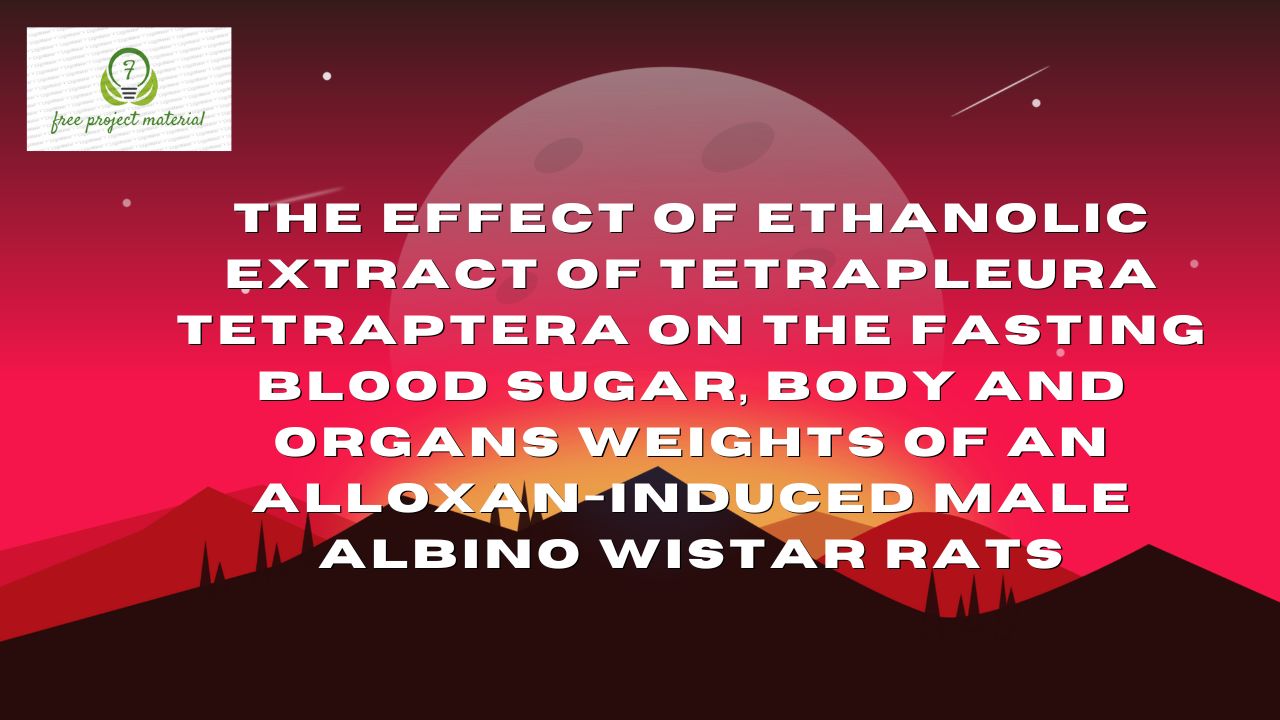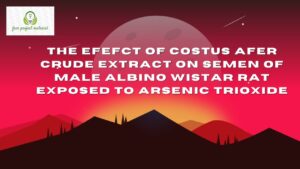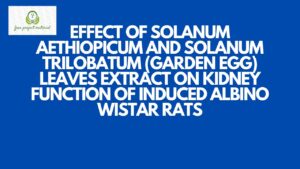ABSTRACT
The study was conducted to investigate the effect of ethanol fruit extract of Tetrapleura tetraptera on the fasting blood glucose, body and organs weights of an alloxan-induced diabetic male albino wistar rats. Twenty four (24) male albino wistar rats of weight 110-160g were randomly assigned six groups of four rats each. Group 6 served as the control. Group 1-5 animals were induced with 150mg/kg body weight of alloxan monohydrate intraperitoneally. Fasting blood glucose was checked 72 hours after induction and animals with blood glucose 200mg/dl and above were considered diabetic. Group 1 was not treated (diabetic control), Group 2 was administered 50mg/kg body weight of metformin, group 3, 4 and 5 were administered 3000 mg/kg, 1000 mg/kg and 2000mg/kg body weight of Tetrapleura tetraptera extract respectively for 14 days. Blood sample was obtained by tail puncture to check glucose levels weekly with the use of glucometer. Animals treated with 3000 mg/kg, 1000 mg/kg and 2000 mg/kg body weight of the extract showed significant decrease (p<0.05) in glucose level and body weight when compared to the untreated group. There was no significant (p>0.05) difference in the organs weight of all the groups. The results obtained in extract treated group were similar to the metformin treated group. This suggest that the fruit extract possesses antidiabetic potential and could be used in the treatment/management of diabetes and its complications.
TABLE OF CONTENTS
Title Page – – – – – – – – – i
Certification – – – – – – – – – ii
Dedication – – – – – – – – – iii
Acknowledgement – – – – – – – – iv
Abstract – – – – – – – – – v
Table of Content – – – – – – – – vi
CHAPTER ONE: INTRODUCTION
1.1 Background of the Study – – – – – – 1
1.2 Aim of the Study – – – – – – – 4
1.3 Objectives of the study – – – – – – 4
1.4 Scope and Limitation of the study – – – – 5
1.5 Definition of Terms – – – – – – 5
CHAPTER TWO: LITERATURE REVIEW
2.1 Description of Tetrapleura tetraptera – – – – 7
2.1.1 Botanical Classification of Tetrapleura tetraptera – – 8
2.2 Nutritional Importance of Tetrapleura tetraptera – – 9
2.3 Pharmacological Activities of Tetrapleura tetraptera – 11
2.3.1 Anticonvulsant activity – – – – – – 11
2.3.2 Central Nervous System-Depressant Properties – – 12
2.3.3 Anti-Inflammatory Activities – – – – – 13
2.3.4 Anti-Malaria Activity – – – – – – 13
2.3.5 Anti-Diabetic Activity – – – – – – 15
2.3.6 Hypolipidaemic and Anti-oxidant Activity – – – 17
2.4 Classification of Diabetes Mellitus – – – – 18
2.4.1 Type 1 diabetes Mellitus – – – – – – 18
2.4.2 Type II diabetes Mellitus – – – – – – 19
2.4.3 Gestational Diabetes Mellitus – – – – – 20
2.5 Plants Reported with Antidiabetic Activity – – – 20
2.6 Review of Precious Studies – – – – – 22
CHAPTER THREE: MATERIALS AND METHODS
3.1 Materials and Reagents – – – – – – 25
3.2 Methods – – – – – – – – 25
3.2.1 Sample Collection and Preparation – – – – 25
3.2.2 Induction of Diabetes – – – – – – 26
3.2.3 Experimental Design – – – – – 27
3.3 Determination of the Fasting Blood Sugar of an
alloxan induced Wistar albino rats – – – – 28
3.3.1 Determination of the body weight of an Alloxan-induced
Wistar albino rats – – – – – – – 28
3.3.2 Determination of Organs weight of an alloxan-induced
Wistar albino rats – – – – – – – 29
3.4 Statistical Analysis – – – – – – 29
CHAPTER FOUR: RESULTS AND DISCUSSION
4.1 Results – – – – – – – – 30
4.2 Discussion – – – – – – – – 33
CHAPTER FIVE: CONCLUSION AND RECOMMENDATIONS
5.1 Conclusion – – – – – – – – 36
5.2 Recommendations – – – – – – – 37
References
CHAPTER ONE: INTRODUCTION
1.1 Background of the Study
Tetrapleura tetraptera is a specie of flowering plant. Many herbal products have been prescribed for the management of diabetes mellitus in ancient and recent literature. Herbal medicines are popularly used remedies for many diseases by a vast majority of the world’s population, because allopathic medicines have large number of side-effects. According to Atawodi, (2011), herbal formulations have attained widespread acceptability as therapeutic agents in many developing countries as anti-diabetics, hepatoprotective and lipid lowering agents.
Tetrapleura tetraptera is a popular medicinal plant belonging to the family Fabaceae (formerly Leguminosae: Mimosoideae), and is commonly known as “Aridan” or “Aidan” among the Yoruba ethnic group of South Western Nigeria, “Abogolo” among the Hausa people of Northern Nigeria. It is generally found in the low land forest of many tropical African countries, and known to have fruit that consist of fleshy pulp and small, brownish-black seeds. According to Aladesanmi (2007), It has been reported that it has a characteristic fragrant and pungent aromatic odor. It is used as popular seasoning spice in southern and Eastern Nigeria, and its fruit is used for the management of convulsions, leprosy, inflammation, rheumatism, flatulence, Jaundice and fevers, as well as the management and control of adult onset type 2 diabetes mellitus. It has been reported that the methanolic extract of the leaf of this plant has antioxidant effect on carbon tetrachloride-induced hepatotoxicity, while the aqueous fruit extract has been shown to possess hypoglycemic properties.
Diabetes mellitus is a group of metabolic diseases characterized by hyperglycemia which results from defects in insulin secretion, insulin action, or both. The chronic hyperglycemia in organisms is associated with long-term damage, dysfunction and failure of various organs, especially the eyes, kidneys, nerves, heart, and blood vessels. The World Health Organization (WHO) estimated that more than 180 million people worldwide have diabetes and this number is projected to double by 2030 when this disorder will affect people, irrespective of sex, age, and socio-economic status. Singh et al., (2007) reported that hyperglycemia and hyperlipidemia are two important characteristics of diabetes mellitus in which diabetic patients experience various vascular complications, such as atherosclerosis, coronary heart disease, diabetic nephropathy and neuropathy. The abnormalities in lipid metabolism generally lead to elevation in the levels of serum lipids and lipoproteins that in turn play important roles in occurrence of premature and severe atherosclerosis which affects patients with diabetes.
Ojewole et al., (2014) reported that conventional drugs used for diabetes treatment are associated with draw backs, such as rigid dosing regimens, high cost and unexpected side effects. Therefore, screening for new anti-diabetic compounds from natural plant used in folk medicine is still attractive, because of their efficacy, low incidence of side effects, and low cost. The LD50 of Tetrapleura tetraptera has been reported to be very high (10,000 mg/kg b-w) which is an indication that it has a very low toxicity risk. This therefore informed the decision to investigate the effect of administration of thirty percent (30%) below the LD50 of Tetrapleura tetraptera in an alloxan-induced diabetic albino wistar rats.
1.2 Aim of the Study
The aim of the study is to investigate the effect of 30% below LD50 of ethanolic extract of Tetrapleura tetraptera fruit on the fasting blood sugar, body and organs weight of alloxan-induced diabetic male albino wistar rats.
1.3 Objectives of the Study
The following are the objectives of the study
- To investigate the pharmacological effect of ethanolic extract of Tetrapleura tetraptera fruit on the blood glucose level of alloxan-induced diabetic male albino wistar rats.
- To investigate the effect of ethanolic extract of Tetrapleura tetraptera fruit on the body weight of alloxan-induced diabetic male albino wistar rats
- To investigate the effect of Tetrapleura tetraptera fruit on the organs weights (liver, kidney, lungs, pancreas and spleen) of alloxan-induced diabetic male albino wistar rats.
1.4 Scope and Limitation of the Study
This research project is designed to investigate the effects of 14 days administration of Tetrapleura tetraptera ethanolic fruit extract on the fasting blood glucose, body and organs weights of an alloxan-induced diabetic male albino wistar rats only. Other parameters were not considered in the analysis due to constraint in time, finance as well as none availability of other biochemical equipment.
1.5 Definition of Terms
Alloxan: Alloxan is used to induce diabetes in experimental animals by destroying the insulin-secreting cells of Langerhans islet in pancreas.
Diabetes: Diabetes is a chronic disease that occurs when the pancreas is no longer able to make insulin, or when the body cannot make good use of the insulin it produces.
Fasting Blood Sugar: A fasting blood glucose test measures the amount of glucose in one’s body. A fasting blood sugar level less than 100 mg/dl (5.6 mmol/L) is normal. A fasting blood sugar level from 100-125 mg/dL (5.6-6.9 mmol/L) is considered prediabetic. If its 126 mg/dl (7 mmol/L) or higher on two separate tests that shows the person is diabetic.
Hyperglycemia: Hyperglycemia is a condition in which an excessive amount of glucose circulates in the blood plasma.



